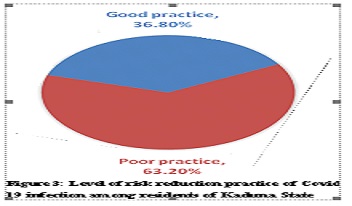Covid-19 Risk Perception and Risk Reduction Practices among the Population of Kaduna State
Mots-clés :
Covid-19, Risk perception, Risk reduction practice, StigmatizationRésumé
Background: Corona Virus Disease (COVID) 19 is a pandemic that has posed many problems to the World. Various measures have been recommended by World Health Organization and American Centre for Disease Control in a bid to prevent and control the spread of the virus. Hence the need to evaluate the risk perception and risk reduction practices of COVID 19 among the residents of Kaduna.
Materials and methods: This was a cross sectional descriptive study conducted in Kaduna State among the general population. Using a multistage sampling method, Four hundred and twenty-seven participants were selected using a structured interviewer administered questionnaire. Data was collected using Open Data Kit Software and analysed using SPSS software version 25
Results: The mean age of the participants was 40±13.9 years old, 61% were males, 81% married, 55% self-employed, 62% practice Islamic religion, 36% had at least secondary education and 59% speaks Hausa and/or Fulani. Majority (99.5) were aware of Covid-19. Seventy four percent of them had good perception of Covid-19 risk, however only 37% of them practiced good Covid-19 risk reduction measures. Most of those who had good knowledge of how Covid-19 is transmitted and how they can prevent themselves from getting the infection were 3 and 6 times more likely to have good perception of Covid-19 risk respectively compared to those with poor knowledge.
Those who knew how Covid-19 is transmitted and those with good perception of Covid-19 were 4 and 5.6 times more likely to practice Covid-19 preventive measures compared to those who did not know and those with poor perception respectively.
Conclusion: Majority of Kaduna State citizens were aware of COVID-19 infection and their risk perception was good. However, their risk reduction practices were poor. Generally, there was a low level of stigmatization among Kaduna residents, and risk reduction practices were influenced by perception, age, occupation and ethnicity.

Téléchargements
Publiée
Licence
(c) Copyright CB Shurkuk, JI Akunne, S Joseph, T Olasinde, SN Kase, T Dahiru, G Emmanuel, I Bakut, SM Babale 2021

Ce travail est disponible sous licence Creative Commons Attribution - Partage dans les Mêmes Conditions 4.0 International.




